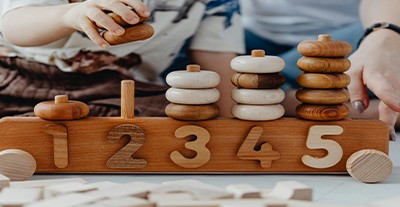Teaching math through play in early childhood is a fantastic way to make learning engaging and natural. The following article provides information on Strategies To Teach Math Through Play, Importance Of Teaching Math Through Play, Using Everyday Activities to Teach Math Concepts In Early Childhood, Mathematical Language in Early Education, Best Practices in Teaching Math, and more.
Strategies To Teach Math Through Play
Counting and Sorting Games
-
Use blocks, buttons, or beads to practice counting and grouping by color or size.
-
Play “How Many?” by asking toddlers to count objects around them (spoons, toys, etc.).
Shape and Pattern Recognition
-
Create shape hunts where children find circles, squares, and triangles in their environment.
-
Use pattern blocks or stickers to build repeating patterns.
Measurement and Comparison
-
Let toddlers pour water into different-sized cups to explore volume.
-
Use hands or feet to measure distances (“How many steps to the door?”).
Pretend Play with Math
-
Set up a play store where children count money and sort items.
-
Play restaurant where they take orders and count plates or utensils.
Outdoor Math Exploration
-
Collect leaves or rocks and count them.
-
Draw numbers and shapes with chalk on the sidewalk.
Hands-On Counting Games
- Hopscotch Math – Draw numbers on the ground and have toddlers jump to the correct answer.
- Snack Counting – Use small snacks (like crackers or fruit) to practice counting and simple addition.
Shape and Pattern Play
-
Shape Collages – Cut out different shapes and let toddlers create pictures using them.
-
Pattern Bracelets – Use beads to make repeating patterns (e.g., red-blue-red-blue).
Measurement and Comparison
-
Tallest Tower Challenge – Build towers with blocks and compare heights.
-
Water Play – Use cups and spoons to explore volume and measurement.
Pretend Play with Math
-
Play Store – Set up a pretend shop where toddlers count money and sort items.
-
Cooking Together – Let toddlers measure ingredients and count scoops while baking.
Outdoor Math Exploration
-
Nature Sorting – Collect leaves, rocks, or flowers and sort them by size or color.
-
Shadow Play – Measure and compare shadows at different times of the day.
Importance Of Teaching Math Through Play
Teaching math through play is essential for early childhood development because it makes learning engaging, natural, and meaningful. Here’s why it matters:
1. Builds a Positive Attitude Toward Math
Many children (and adults!) develop math anxiety, but play-based learning helps them see math as fun and approachable rather than intimidating.
2. Encourages Hands-On Exploration
Math concepts become tangible when children interact with objects—counting blocks, sorting shapes, or measuring ingredients while cooking.
3. Develops Problem-Solving Skills
Through play, children experiment, test ideas, and find solutions, strengthening their ability to think critically and solve problems.
4. Supports Cognitive and Social Growth
Math play fosters logical thinking, memory, and reasoning while also encouraging collaboration and communication with peers.
5. Makes Learning Meaningful and Relevant
Using Everyday Activities to Teach Math Concepts In Early Childhood
When math is integrated into everyday activities—like building towers, playing store, or measuring water—children see its real-world applications.
Teaching math through everyday activities makes learning natural, engaging, and fun for young children! Here are some simple ways to integrate math into daily routines:
1. Counting in Daily Life
-
Count steps while walking or climbing stairs.
-
Count snacks (e.g., “How many crackers do you have?”).
2. Sorting and Patterns
-
Sort laundry by color or size.
-
Arrange toys in patterns (e.g., car-doll-car-doll).
3. Measurement and Comparison
-
Use a ruler or measuring tape to compare objects.
-
Pour water into different-sized cups to explore volume.
4. Shapes in the Environment
-
Find circles, squares, and triangles in everyday objects.
-
Use string or chalk to trace shapes outside.
5. Math in Cooking
-
Count ingredients while baking.
-
Compare the sizes of measuring cups.
Mathematical Language in Early Education
Mathematical language plays a crucial role in early education, helping children develop foundational numeracy skills and confidence in math. Here’s how it supports learning:
1. Types of Mathematical Language
-
Quantitative Words – Terms like more, fewer, equal, add, subtract help children compare amounts and understand basic operations.
-
Spatial and Ordinal Words – Words like above, below, first, last, next support understanding of position and sequence.
-
Measurement Terms – Concepts like longer, shorter, heavier, lighter introduce comparisons and estimation.
2. Importance of Mathematical Language
-
Enhances Problem-Solving – Using math vocabulary helps children articulate their reasoning and approach challenges logically.
-
Supports Early Numeracy – Understanding math-related words improves counting, sorting, and pattern recognition.
-
Encourages Communication – Talking about math concepts builds confidence and helps children express their thinking.
3. Strategies to Develop Mathematical Language
-
Use Math Talk in Daily Activities – Ask questions like “Which tower is taller?” or “How many apples do we have?”.
-
Play-Based Learning – Games like sorting objects, measuring ingredients, or building structures reinforce math vocabulary.
-
Storytelling and Books – Reading stories that include math concepts helps children connect words to real-world situations.
Best Practices in Teaching Math
Effective math teaching involves strategies that make learning engaging, meaningful, and accessible for students. Here are some best practices to consider:
1. Use Hands-On Learning
Incorporate math manipulatives like blocks, counters, and geometric shapes to help students visualize concepts.
2. Encourage Mathematical Discourse
Facilitate discussions where students explain their reasoning, compare approaches, and engage in problem-solving.
3. Focus on Conceptual Understanding
Rather than memorization, emphasize why math works—helping students build a strong foundation for problem-solving.
4. Integrate Real-World Applications
Connect math to everyday life, STEM fields, and practical scenarios to make learning relevant and engaging.
5. Promote a Growth Mindset
Encourage students to embrace challenges and see mistakes as learning opportunities, reducing math anxiety.
Further Reading
Numeracy Activities For Children In Early Childhood
Numeracy Indicators In The Early Years
Children's Learning Through Numeracy
